A Mobile App to Learn About Cultural and Historical Associations in a Closed Loop with Humanities Experts
Abstract
1. Introduction
2. CrossCult Overview
- Pilot 1 worked with the collection of paintings of the National Gallery London, providing itineraries tailored to the individual interests of each visitor.
- Pilot 2 (the focus of this paper) developed quiz games, stories, and associations between the Roman healing spas of Lugo (Spain) and Chaves (Portugal), the sanctuary of Epidaurus (Greece) and the archaeological site of Montegrotto Terme (Italy).
- Pilot 3 focused on enriching the visits in the small venue, the Archaeological Museum of Tripolis (Greece), by means of stories that bring together several exhibits in relation to current topics.
- Finally, Pilot 4 developed means to capture citizens’ reflections about the history and heritage captured in outdoor locations, driven by gamification elements that were first put into practice in the cities of Luxembourg and Valetta (Malta).
3. The Pilot 2 Mobile App
4. The Experts’ Tool
- : word cosine distance.
- #: the cardinality of a set.
- : the set of entities in a sequence of triples.
- : the set of keywords linked to a reflective topic.
- : the set of keywords in the expert’s profile.
5. Evaluation
- While the users were faced with an average of 11.7 highlights in the app, they would rate only 5.3 with one of the emojis—either because they did not read the rest of the highlights or they did not find any of the emojis to be representative enough. From among the replies, 67.6% of the users would choose interested (“that’s good to know”), reflecting (“that makes me think”) or surprised (“that’s surprising”) emojis; 27% of the users would click on the smirking (“I knew that already”) face, while only 5.4% would express indifference or lack of interest (“who cares!”).
- 91.4% of the users who reached the end of the experience (i.e., who went through all the reflective topics) would provide textual comments at the screen of Figure 8, and the average number of comments provided by those was 3.1.
- According to the data of Table 1, nearly of the users had negative opinions about the app, and more than did not perceive much added value in the graph visualizations of concepts and associations. This datum correlates with the indication that it would be better to use the app on a larger screen than offered by a smartphone, and that things would be much easier to understand with a teacher or guide browsing/explaining the contents. In contrast, the features related to the stories, the multiple-choice questions and the reflection points were appealing to an average of 90% of the users.
- 35.5% of the users indicated that they ended up with a richer understanding of life in the Roman period, while 61% had a neutral opinion. The little textual feedback gathered in this regard suggested that the statement was probably too ambitious for the relatively short time spent with the app. Besides, there is the fact that more than 78% of the users who completed the profiling questionnaire in the app were rated as knowledgeable ones, which suggests that our sample of University students already had a decent historical background.
- Finally, owing to the data gathered from the paper-based questionnaire, nearly 70% of the users agreed that the app can enrich the visit of one of its cultural venues (preferably, if used before the visit), while 40% said that it can also instigate curiosity about the distant ones. Disagreement with these statements was null or very low (14.6%).
6. Conclusions and Future Work
Author Contributions
Funding
Conflicts of Interest
Abbreviations
| EU | European Union |
| CCKB | CrossCult Knowledge Base |
| CIDOC | ICOM International Committee for Documentation |
| JSON | JavaScript Object Notation |
| WCD | Word Cosine Distance |
References
- Arthur, J.; Phillips, R. Issues in History Teaching; RoutledgeFalmer: London, UK, 2012. [Google Scholar]
- Al Ashmawi, F.; Reiss, W.; Dougi, N.; Riley, M.; Hassani Idrissi, M.; Thurfjell, D. On a Common Path: New Approaches to Writing History Textbooks in Europe and the Arab and Islamic Worlds: The Case of the Mediterranean; ISESCO, UNESCO: Rabat, Morocco, 2012; Available online: http://unesdoc.unesco.org/images/0022/002270/227041e.pdf (accessed on 27 March 2018).
- Anderson, E.F.; McLoughlin, L.; Liarokapis, F.; Peters, C.; Petridis, P.; de Freitas, S. Developing serious games for cultural heritage: A state-of-the-art review. Virtual Real. 2010, 14, 255–275. [Google Scholar] [CrossRef]
- Bodenhamer, D. The Spatial Humanities: Space, Time and Place in the New Digital Age. In History in the Digital Age; RoutledgeFalmer: London, UK, 2012. [Google Scholar]
- Mayr, E.; Windhager, F. Once upon a spacetime: Visual storytelling in cognitive and geotemporal information spaces. ISPRS Int. J. Geo-Inf. 2018, 7, 96. [Google Scholar] [CrossRef]
- Belhi, A.; Bouras, A.; Foufou, S. Leveraging known data for missing label prediction in cultural heritage context. Appl. Sci. 2018, 8, 1768. [Google Scholar] [CrossRef]
- Vavliakis, K.N.; Karagiannis, G.; Mitkas, P.A. Semantic Web in cultural heritage after 2020. In Proceedings of the 11th International Semantic Web Conference (ISWC), Boston, MA, USA, 11–15 November 2012. [Google Scholar]
- Ardissono, L.; Kuflik, T.; Petrelli, D. Personalization in cultural heritage: The road travelled and the one ahead. User Model. User-Adapt. Interact. 2012, 22, 73–99. [Google Scholar] [CrossRef]
- Bartolini, I.; Moscato, V.; Pensa, R.G.; Penta, A.; Picariello, A.; Sansone, C.; Sapino, M.L. Recommending multimedia visiting paths in cultural heritage applications. Multimed. Tools Appl. 2016, 75, 3813–3842. [Google Scholar] [CrossRef]
- Roussou, M.; Katifori, A. Flow, staging, wayfinding, personalization: Evaluating user experience with mobile museum narratives. Multimodal Technol. Interact. 2018, 2, 32. [Google Scholar] [CrossRef]
- Le, T.M.V.; Lauw, H.W. Semantic visualization with neighborhood graph regularization. J. Artif. Intell. Res. 2016, 55, 1091–1133. [Google Scholar] [CrossRef]
- Tong, C.; Roberts, R.; Borgo, R.; Walton, S.; Laramee, R.S.; Wegba, K.; Lu, A.; Wang, Y.; Qu, H.; Luo, Q.; Ma, X. Storytelling and visualization: An extended survey. Information 2018, 9, 65. [Google Scholar] [CrossRef]
- Lombardo, V.; Damiano, R. Storytelling on mobile devices for cultural heritage. New Rev. Hypermed. Multimed. 2012, 18, 11–35. [Google Scholar] [CrossRef]
- Tanenbaum, K.; Hatala, M.; Tanenbaum, J.; Wakkary, R.; Antle, A. A case study of intended versus actual experience of adaptivity in a tangible storytelling system. User Model. User-Adapt. Interact. 2014, 24, 175–217. [Google Scholar] [CrossRef]
- Doerr, M. The CIDOC Conceptual Reference Module: An ontological approach to semantic interoperability of metadata. AI Mag. 2003, 24, 75–92. [Google Scholar]
- Myers, D.; Dalgity, A.; Avramides, I. The arches heritage inventory and management system: 5 platform for the heritage field. J. Cult. Herit. Manag. Sustain. Dev. 2016, 6, 213–224. [Google Scholar] [CrossRef]
- Jones, C.; Vlachidis, A.; Bikakis, A.; Lykourentzou, I. Pilot Specifications. CrossCult Deliverable 2.1. 2016. Available online: http://www.crosscult.eu/en/resources/deliverables/ (accessed on 26 September 2018).
- Bravo-Quezada, O.; López-Nores, M.; García-Nogueiras, I.; Perdiz-Gradín, D.; Blanco-Fernández, Y.; Pazos-Arias, J.; Gil-Solla, A.; Ramos-Cabrer, M. A semantics-based exploratory game to enrich school classes with relevant historical facts. In Proceedings of the 11th International Workshop on Semantic and Social Media Adaptation and Personalization (SMAP), Thessaloniki, Greece, 20–21 October 2016; pp. 128–132. [Google Scholar]
- Chasin, R.; Woodward, D.; Witmer, J.; Kalita, J. Extracting and displaying temporal and geospatial entities from articles on historical events. Comput. J. 2014, 57, 403–426. [Google Scholar] [CrossRef]
- Hienert, D.; Luciano, F. Extraction of historical events from Wikipedia. Lect. Notes Comput. Sci. 2015, 7540, 16–28. [Google Scholar]
- Jatowt, A.; Kawai, D.; Tanaka, K. Digital history meets Wikipedia: Analyzing historical persons in Wikipedia. In Proceedings of the ACM/IEEE Joint Conference on Digital Libraries (JCDL), Neward, NJ, USA, 17–26 June 2016. [Google Scholar]
- Rector, L.H. Comparison of Wikipedia and other encyclopedias for accuracy, breadth, and depth in historical articles. Ref. Serv. Rev. 2008, 36, 7–22. [Google Scholar] [CrossRef]
- Vassilakis, C.; Deladiennee, L.; López-Nores, M.; Giménez-Molina, R. Programmer’s Guide for Data Management and Service Invocation—First Version. CrossCult Deliverable 4.3. 2017. Available online: http://www.crosscult.eu/en/resources/deliverables/ (accessed on 26 September 2018).
- Mikolov, T.; Chen, K.; Corrado, G.; Dean, J. Efficient estimation of word representations in vector space. arXiv, 2013; arXiv:1301.3781. [Google Scholar]
- Speer, R.; Chin, J.; Havasi, C. Conceptnet 5.5: An open multilingual graph of general knowledge. In Proceedings of the 31st AAAI Conference on Artificial Intelligence, San Francisco, CA, USA, 4–9 February 2017; pp. 4444–4451. [Google Scholar]
- Loewenstein, G. The psychology of curiosity: A review and reinterpretation. Psychol. Bull. 1994, 116, 75. [Google Scholar] [CrossRef]
- Origlia, A.; Chiacchio, M.L.; Di Mauro, D.; Cutugno, F. Why so serious? Raising curiosity towards cultural heritage with playful games. In Proceedings of the 10th International Workshop on Artificial Intelligence for Cultural Heritage (AI*CH), Genoa, Italy, 18–25 July 2016. [Google Scholar]
- Tan, W.-K.; Chang, Y.-G. Electronic-word-of-mouth performance in different psychological distances and familiarity. Online Inf. Rev. 2015, 39, 449–465. [Google Scholar] [CrossRef]

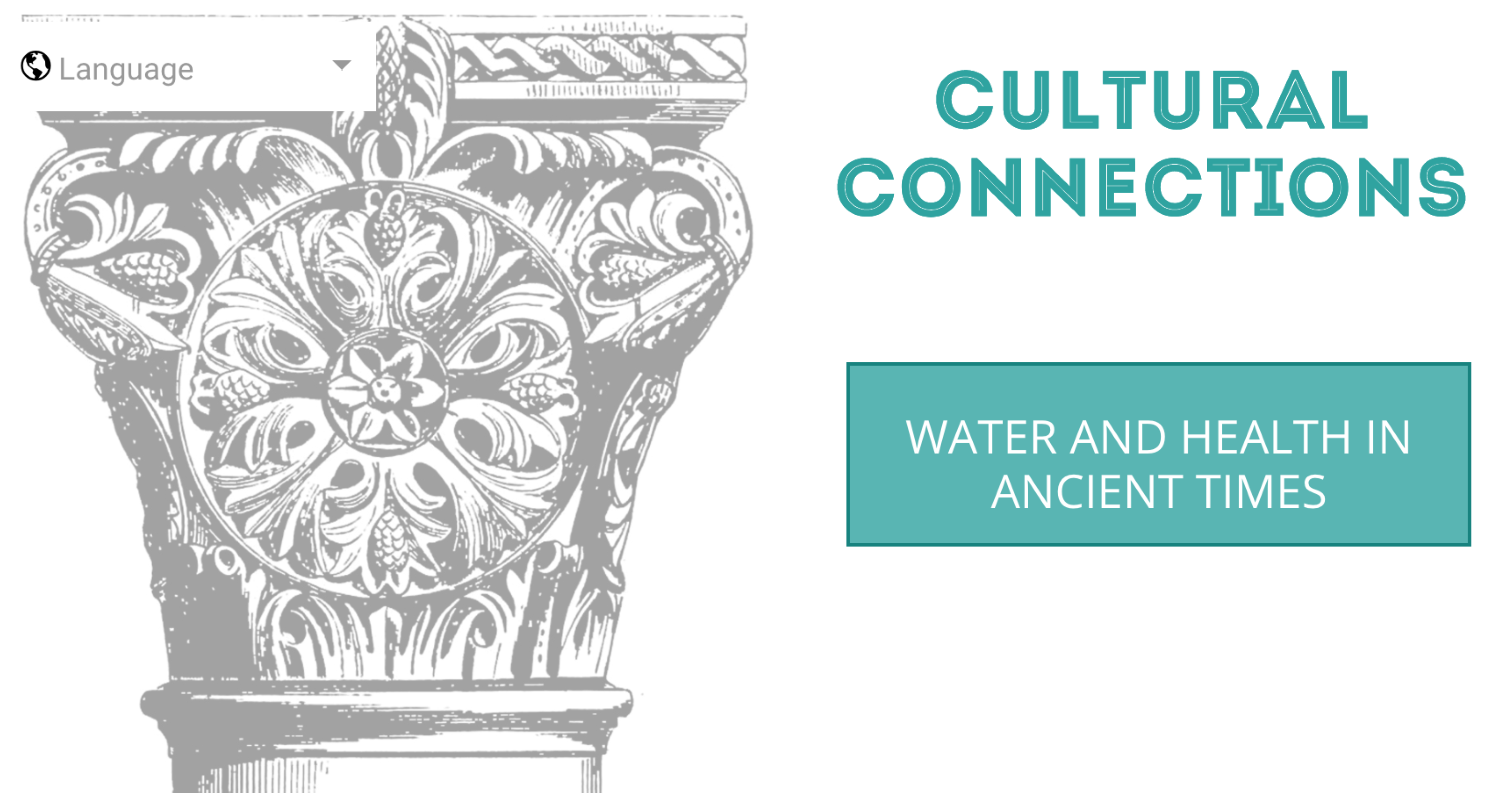

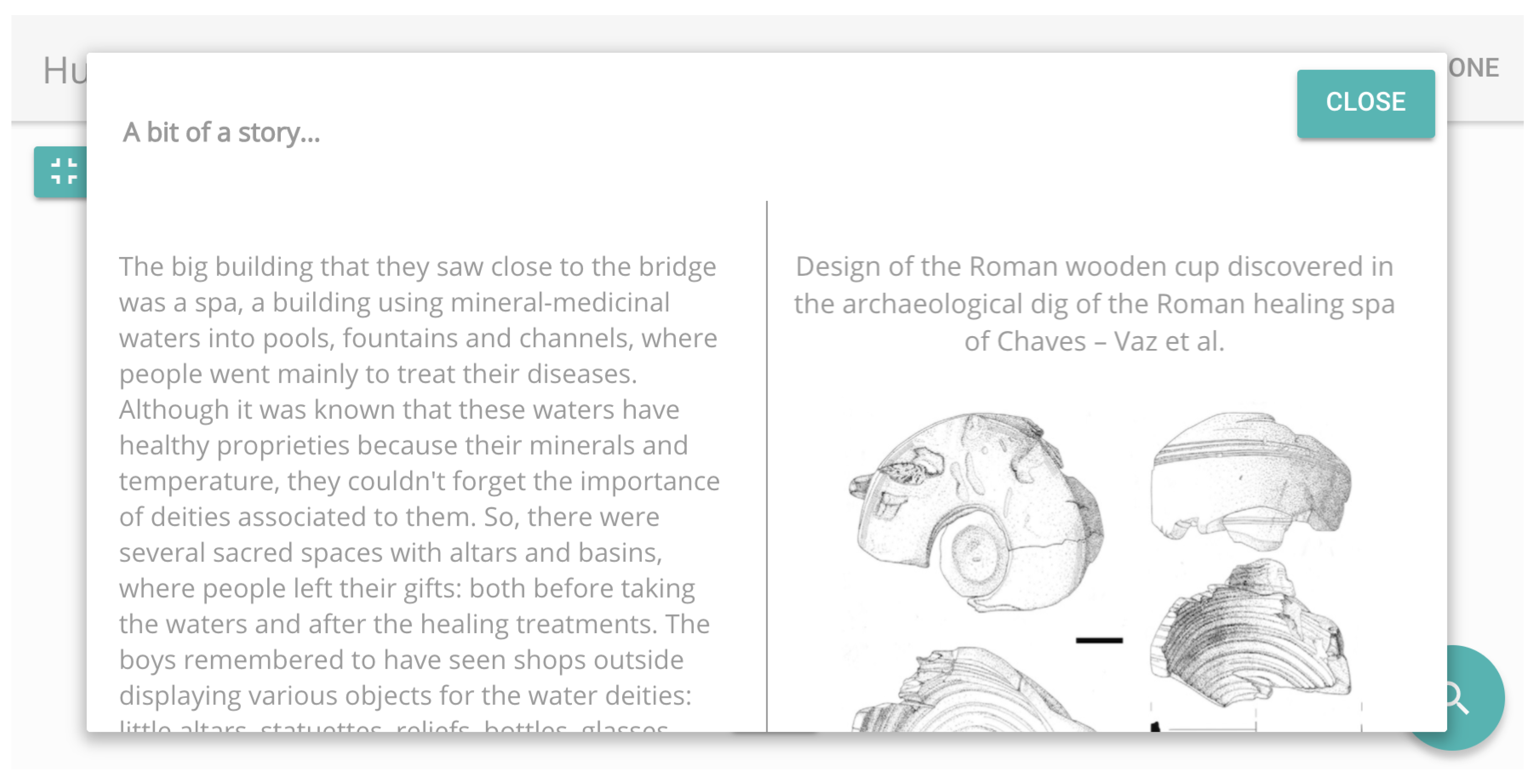
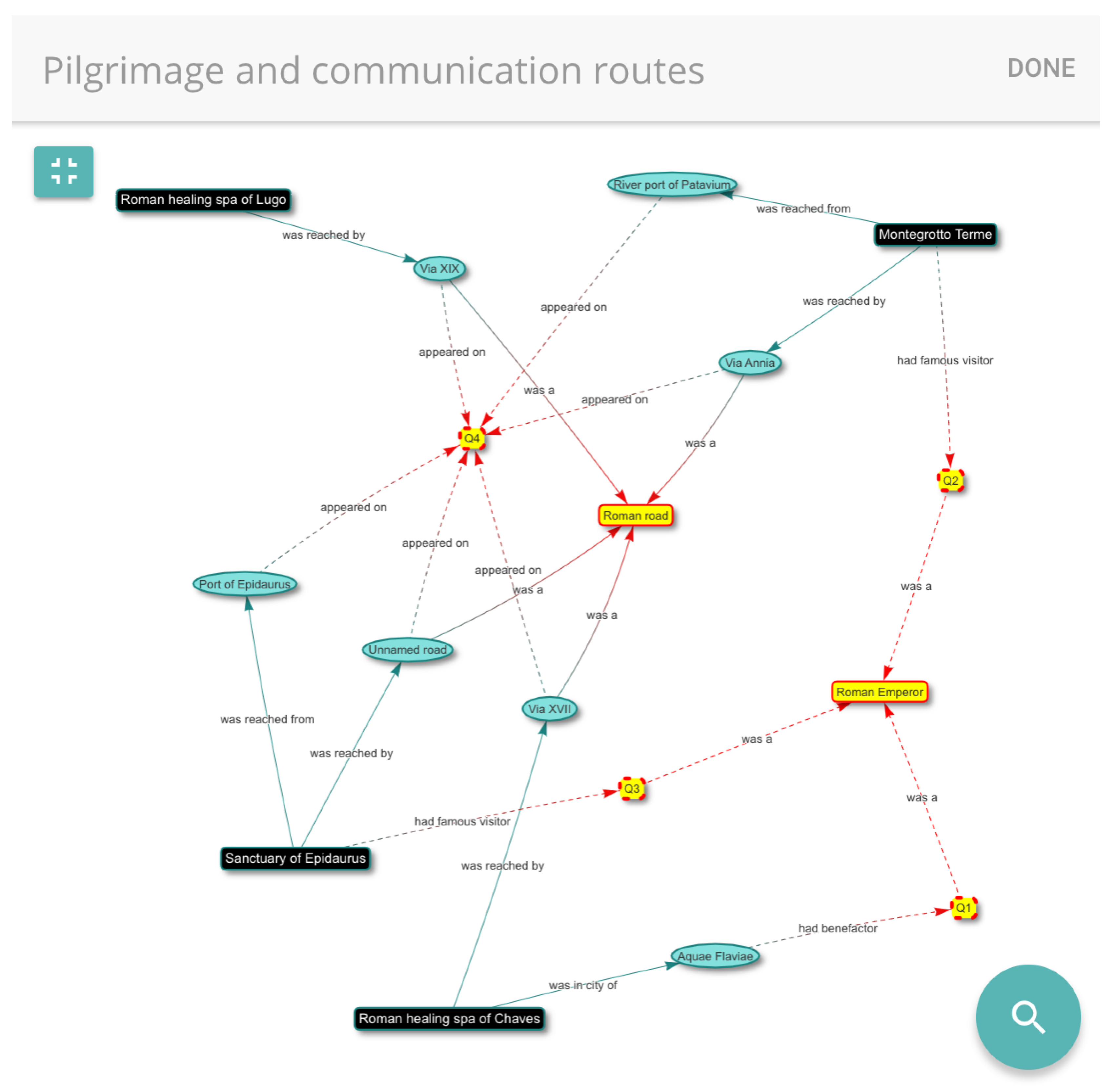
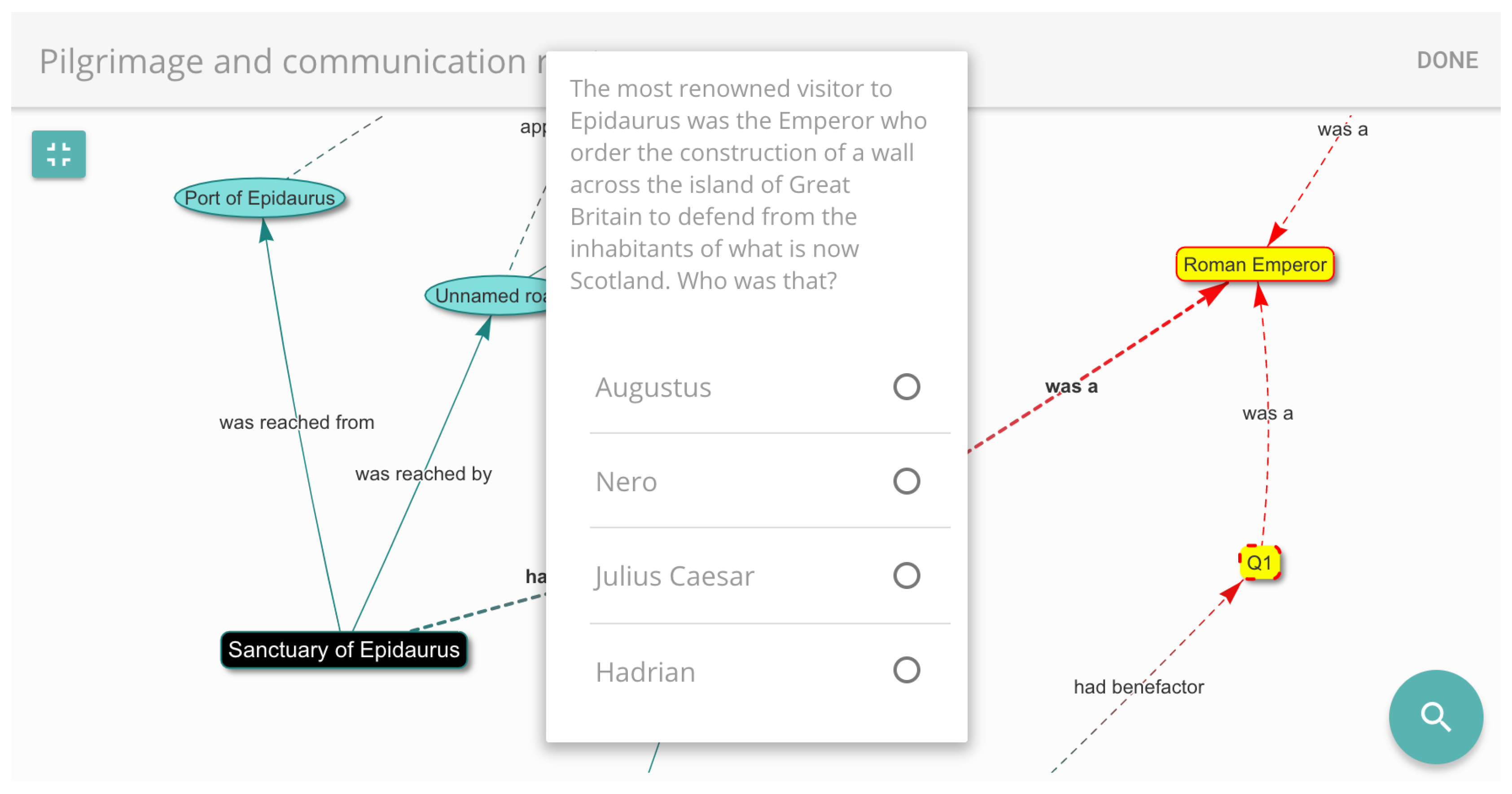

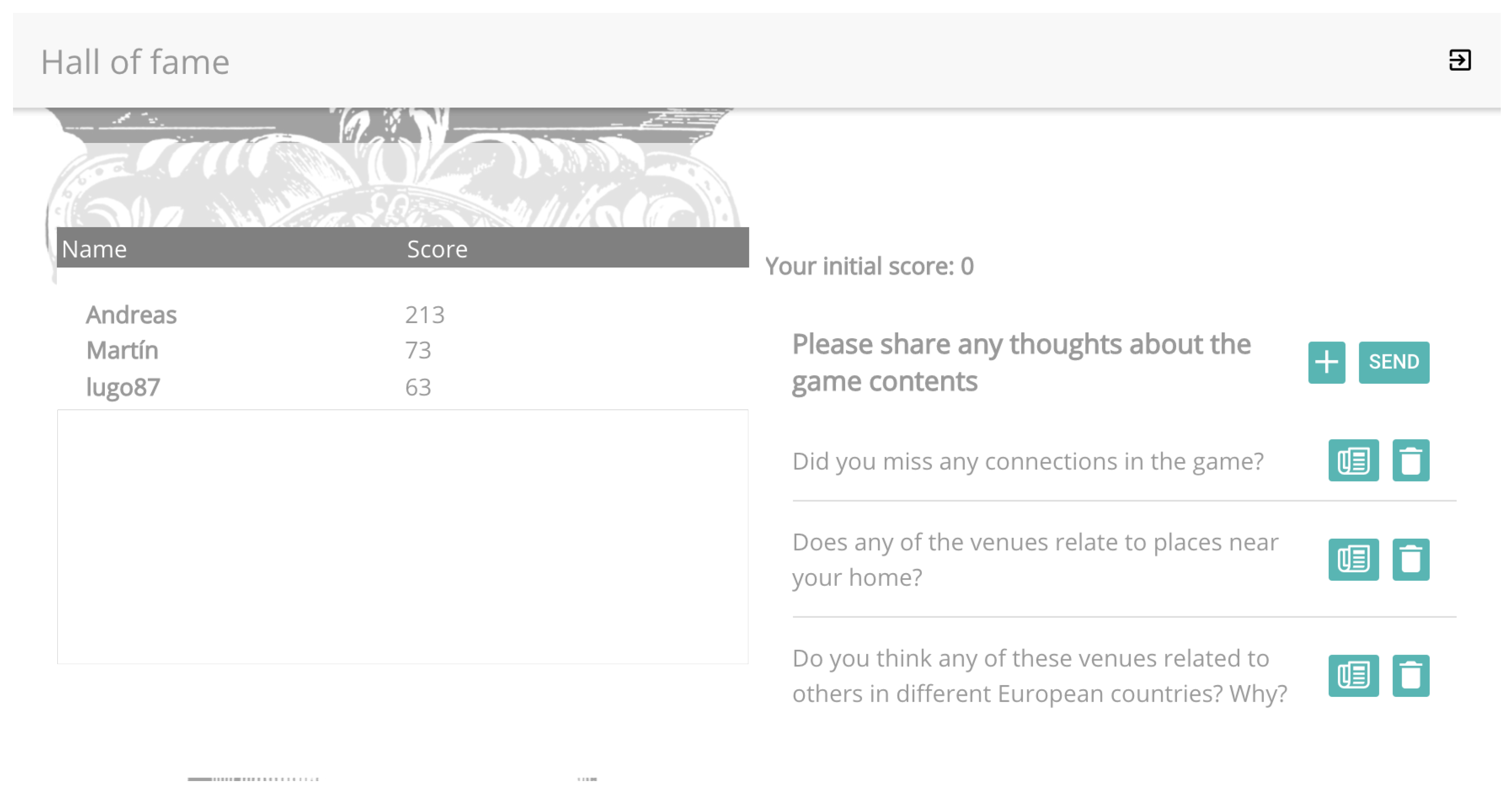
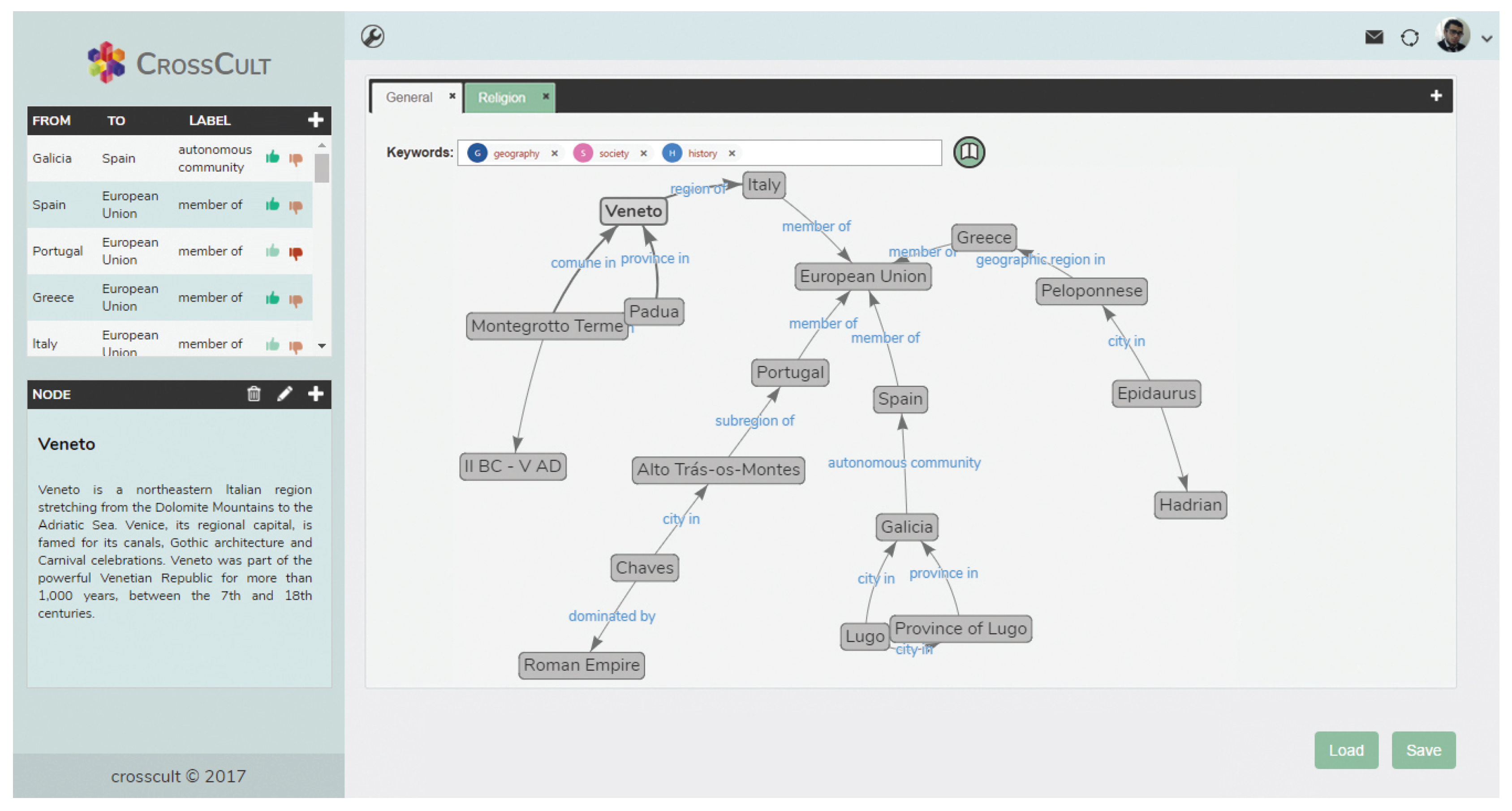
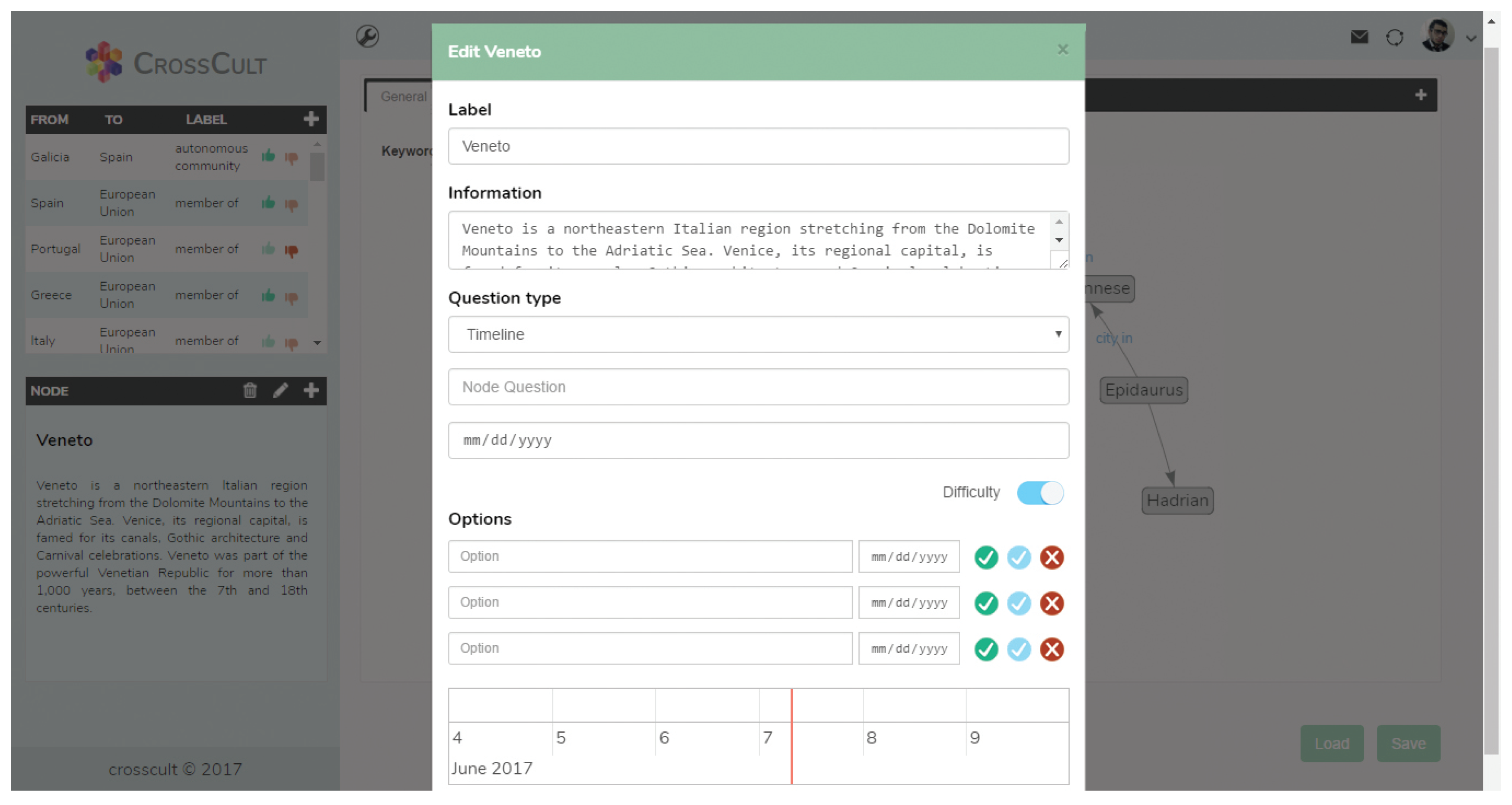
| Disagree | Neutral | Agree | |
|---|---|---|---|
| I enjoyed using the app | 25.7% | 43.1% | 31.2% |
| The story is a nice driver of the whole experience | 11.3% | 42.4% | 46.3% |
| The story made me reflect about the topics of the experience | 11.5% | 30.5% | 58% |
| The graphs of concepts and associations were informative and easy to understand | 38.7% | 34.6% | 26.7% |
| The graphs of concepts and associations made me reflect about the topics of the experience | 36.9% | 28.6% | 34.5% |
| The multiple-choice questions in the game made me reflect about the topics of the experience | 5.4% | 31% | 63.6% |
| I liked reading about historical facts and giving my feedback via emojis | 6.2% | 50.3% | 43.5% |
| The historical facts made me reflect about the topics of the experience | 8.1% | 33.8% | 58.1% |
| I enjoyed providing my reflection comments and my own associations in the end | 28% | 41.3% | 30.7% |
| I ended up with a richer understanding of life in the ancient times | 3.5% | 61% | 35.5% |
| The app triggers my curiosity about the distant venues | 14.6% | 45.8% | 39.6% |
| I think the app can enrich the experience of visiting one of its cultural venues | 0% | 30.2% | 69.8% |
| I think the app can be enriching if used BEFORE visiting one of its cultural venues | 6.3% | 25.8% | 67.9% |
| I think the app can be enriching if used AFTER visiting one of its cultural venues | 14.5% | 41% | 45.5% |
| I think the app is much more suited to tablets than smartphones due to the larger screen size | 7.3% | 18.1% | 74.6% |
| I think the app could be an interesting tool in a classroom, with teachers browsing/explaining the contents and playing the game as per the students’ instructions | 0% | 24.6% | 75.4% |
© 2018 by the authors. Licensee MDPI, Basel, Switzerland. This article is an open access article distributed under the terms and conditions of the Creative Commons Attribution (CC BY) license (http://creativecommons.org/licenses/by/4.0/).
Share and Cite
Daif, A.; Dahroug, A.T.; López-Nores, M.; González-Soutelo, S.; Bassani, M.; Antoniou, A.; Gil-Solla, A.; Ramos-Cabrer, M.; Pazos-Arias, J.J. A Mobile App to Learn About Cultural and Historical Associations in a Closed Loop with Humanities Experts. Appl. Sci. 2019, 9, 9. https://doi.org/10.3390/app9010009
Daif A, Dahroug AT, López-Nores M, González-Soutelo S, Bassani M, Antoniou A, Gil-Solla A, Ramos-Cabrer M, Pazos-Arias JJ. A Mobile App to Learn About Cultural and Historical Associations in a Closed Loop with Humanities Experts. Applied Sciences. 2019; 9(1):9. https://doi.org/10.3390/app9010009
Chicago/Turabian StyleDaif, Abdullah, Ahmed Tarek Dahroug, Martín López-Nores, Silvia González-Soutelo, Maddalena Bassani, Angeliki Antoniou, Alberto Gil-Solla, Manuel Ramos-Cabrer, and José J. Pazos-Arias. 2019. "A Mobile App to Learn About Cultural and Historical Associations in a Closed Loop with Humanities Experts" Applied Sciences 9, no. 1: 9. https://doi.org/10.3390/app9010009
APA StyleDaif, A., Dahroug, A. T., López-Nores, M., González-Soutelo, S., Bassani, M., Antoniou, A., Gil-Solla, A., Ramos-Cabrer, M., & Pazos-Arias, J. J. (2019). A Mobile App to Learn About Cultural and Historical Associations in a Closed Loop with Humanities Experts. Applied Sciences, 9(1), 9. https://doi.org/10.3390/app9010009









